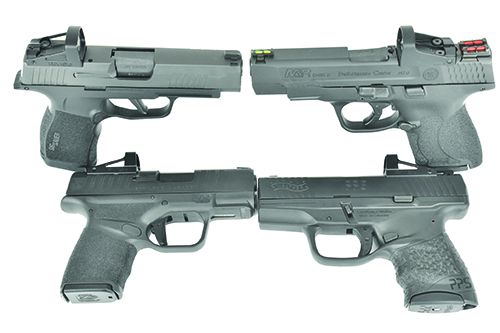It may be too simplistic to suggest that competition drives most of the technical advances in the USA today, but sports are nothing if not competition. Just like NASCAR or Formula One racing, technology filters down to the family SUV, the technological advances developed for competitive shooting wind up, eventually, in your everyday carry pistol or hunting rifle. Competition, however, in spite of our best wishes, is not the real world. No matter how realistic the game, we are frequently willing to take risks in our actions or our equipment that would not be acceptable if a life was on the line. Optical sights are a good example of questionable technology. Jerry Barnhart won the 1990 United States Practical Shooting Association National Championship and was the first person to do so with an optical sight. No one has won the Open Division of USPSA since then using iron sights. But targets don’t shoot back.
So, can you bet your life on these sights? Non-magnified red-dot sights are faster and more accurate to use than iron sights. Why else do you think the U.S. military uses them? Why do you think major police departments are starting to adopt them?
We have seen the trend toward red-dot sights on everyday carry (EDC) pistols for some time now. At first, they were big, bulky, and somewhat fragile – not suitable for EDC. Now they are smaller, and the newest generation can be mounted directly to the slide. We also have a whole new crop of EDC-type pistols that come from the factory ready to mount the red-dot sights. Do red dots really improve performance on a small pistol? At self-defense distances? Are they durable over hundreds of rounds?
We tested four different pistols for you using essentially the same optic to help find out. We used the Shield Reflex Mini Sight Compact (RMSc). Since the initial design in 1996, the original mini-sight has been sold over the years under many names you may well know: Firepoint, Tasco Optima, Trijicon RedDot and JPoint. This parallax-free sight uses a clear polymer optic which, the company claims, is able to withstand more shock than products using a glass optic. The sight body is made from aircraft-grade aluminum and has a matte-black finish. It also employs a variable-intensity drive circuit that senses target light levels and controls the brightness of the LED output to give you the best visibility in varying light levels. Average battery life is supposed to be two to three years. Can the sight survive the tests? Which pistol benefitted most from the addition of the red dot? Does the addition of a more precise aiming system change the utility of the pistol?
9MM Luger Range Data
| Black Hills HoneyBadger 100-grain FTM | SIG Sauer P365XL | S&W Shield 2.0 | Walther PPS M2 | Springfield Hellcat |
| Average Velocity | 1186 fps | 1176 fps | 1170 fps | 1138 fps |
| Muzzle Energy | 313 ft.-lbs. | 307 ft.-lbs. | 304 ft.-lbs. | 287 ft.-lbs. |
| Average Group | 2.04 in. | 1.00 in. | 2.1 in. | 2.01 in. |
| SIG Sauer V-Crown 115-grain JHP | SIG Sauer P365XL | S&W Shield 2.0 | Walther PPS M2 | Springfield Hellcat |
| Average Velocity | 1156 fps | 1198 fps | 1121 fps | 1139 fps |
| Muzzle Energy | 338 ft.-lbs. | 363 ft.-lbs. | 318 ft.-lbs. | 328 ft.-lbs. |
| Average Group | 1.73 in. | 1.84 in. | 2.15 in. | 1.65 in. |
| Speer Gold Dot 124-grain JHP | SIG Sauer P365XL | S&W Shield 2.0 | Walther PPS M2 | Springfield Hellcat |
| Average Velocity | 1100 fps | 1101 fps | 1098 fps | 1139 fps |
| Muzzle Energy | 334 ft.-lbs. | 307 ft.-lbs. | 332 ft.-lbs. | 328 ft.-lbs. |
| Average Group | 1.46 in. | 1.95 in. | 1.93 in. | 1.19 in. |
| Black Hills HoneyBadger 125-grain Subsonic FTM | SIG Sauer P365XL | S&W Shield 2.0 | Walther PPS M2 | Springfield Hellcat |
| Average Velocity | 983 fps | 955 fps | 980 fps | 989 fps |
| Muzzle Energy | 268 ft.-lbs. | 253 ft.-lbs. | 266 ft.-lbs. | 272 ft.-lbs. |
| Average Group | 1.33 in. | 2.08 in. | 2.47 in. | 1.64 in. |
How We Tested
We felt that to test the effectiveness of a red-dot sighting system on an EDC, we needed to have pistols for which we could also obtain baseline scores in our drills using iron sights. To do that, we got a Springfield Armory Hellcat OSP (Optical Sight Pistol) model and added the Shield RMSc red-dot sight ($400 at Brownells.com, #100-023-736WB). We added the same sight to the SIG Sauer P365XL 365XL9BXR3 ($579 at BudsGunShop.com) and mounted the supplied Shield SMS (Shield Mini Sight, made expressly for the Smith & Wesson Shield) to a Smith & Wesson Performance Center Shield Model 2.0 11786 with a 4-inch barrel ($735 at BudsGunShop.com and price includes the sight). For extra measure, we added in a Walther PPS M2 2805961, $649 (GunBroker.com best price). This package also includes the Shield RMSc sight.
All pistols were shot from a well-sandbagged rest for accuracy at American Shooting Centers (AMshootcenters.com). We chronographed each load using a Labradar device and recorded multiple five-shot groups for each pistol shot at 15 yards. Other drills ranging in distance from 5 to 50 yards were shot offhand. We launched a variety of cartridge brands, shapes, and sizes downrange to test for accuracy and function. For self-defense ammo, we tested Black Hills 100-grain HoneyBadger as well as the 125-grain subsonic HoneyBadger, the 115-grain SIG Sauer 365 V-Crown JHP, and 124-grain Speer Gold Dots. We used Remington Green Box 124-grain FMJ for most of the action shooting. Tabulated results appear in the nearby Range Data sidebar.
| DRILL #1 Data | ||||||
| Pistol | Magazine Used | Time to First Shot (seconds) | Split Average (seconds) | Total Time (seconds) | ||
| SIG P365XL | Flush | 1.09 | 0.28 | 2.21 | ||
| Extended | 1.07 | 0.25 | 2.05 | |||
| S&W Shield | Flush | 1.28 | 0.32 | 2.37 | ||
| Extended | 1.21 | 0.24 | 2.49 | |||
| Walther PPS M2 | Flush | 1.07 | 0.3 | 2.26 | ||
| Extended | 1.13 | 0.31 | 2.37 | |||
| Springfield Hellcat | Flush | 1.22 | 0.33 | 2.52 | ||
| Extended | 1.18 | 0.33 | 2.49 | |||
| DRILL #2 Data (5x5x5) | ||||||
| Pistol | Magazine Used | Time to First Shot (seconds) | Split Average (seconds) | Total Time (seconds) | ||
| SIG P365XL | Flush | 1.58 | 0.32 | 2.94 | ||
| Extended | 1.64 | 0.28 | 2.99 | |||
| S&W Shield | Flush | 1.66 | 0.32 | 2.94 | ||
| Extended | 1.64 | 0.28 | 2.76 | |||
| Walther PPS M2 | Flush | 1.89 | 0.44 | 3.63 | ||
| Extended | 1.79 | 0.4 | 3.37 | |||
| Springfield Hellcat | Flush | 2.08 | 0.51 | 4.12 | ||
| Extended | 1.94 | 0.41 | 3.6 | |||
| Drill #3 | ||||||
| Pistol | Sights Used | Time to First Shot (seconds) | Split Average (seconds) | Total Time (seconds) | Points | Comstock Score |
| SIG P365XL | Irons | 1.36 | 0.57 | 3.74 | 17 | 4.55 |
| Red dot | 1.26 | 0.44 | 3.01 | 25 | 8.31 | |
| S&W Shield | Irons | 1.27 | 0.51 | 3.3 | 25 | 7.58 |
| Red dot | 1.22 | 0.52 | 3.31 | 21 | 6.34 | |
| Walther PPS M2 | Irons | 1.43 | 0.61 | 3.85 | 25 | 6.49 |
| Red dot | 1.5 | 0.53 | 3.59 | 25 | 6.96 | |
| Springfield Hellcat | Irons | 1.31 | 0.57 | 3.58 | 21 | 5.87 |
| Red dot | 1.17 | 0.56 | 3.42 | 21 | 6.14 | |
| Drill #4 | ||||||
| Pistol | Results (Hits/Shots) | Final Hit Distance (yards) | ||||
| SIG P365XL | 14/15 | 29 | ||||
| S&W Shield | 13/15 | 28 | ||||
| Walther PPS M2 | 13/15 | 28 | ||||
| Springfield Hellcat | 14/15 | 29 |
Drill #2 Process: Draw from a concealment holster. Fire 5 shots into a 5-inch circle at 5 yards.
Drill #3 Process: Take five shots at USPSA target from low ready, 15 yards, 25 points max possible. A-zone hits, 5 points; C-zone hits, 2 points; D-zone hits, 1 point. Comstock score is total points divided by time.
Drill #4 Process: Start at 11 yards, shoot at 8-inch plate. Take one big step back at each hit. Limit 15 rounds per pistol.
Initial Lessons
Size matters. We know this is subjective, but we considered the felt recoil of the smaller Hellcat and Walther to be noticeably heavier than the SIG or the Smith & Wesson. The times of the two smaller pistols were also slower in the drills.
Dots matter. The pistols averaged more than a 20% improvement in accuracy, as measured by group size, when using the Shield RMSc versus iron sights. The red-dot-sighted pistols beat the iron-sighted versions of the pistols on 77% of the drills – sometimes by as much as 85%.
Magazines matter. We tested the pistols in drills using the flush-fit magazine versus the extended magazines. The longer magazines won based on score and time in 87% of those tests.
Sights matter. We shot almost 1000 rounds in four different pistols using four different sights. They all worked perfectly. Our only issue with the Shield RMSc was the way the intensity of the dot was controlled. Most of the time, the proper brightness selected was perfect. However, when we were in bright light and the target was dim or vice versa, we sometimes had too bright of a dot and it was a bit hard to center. Seeing the dot was never a problem.
Shooting the pistols with a red-dot sight mounted requires a slightly different technique than with iron sights. Bring the pistol up into the line of sight, look through the viewport in the sight, find the dot, place that dot on the target and press the trigger smoothly. If the shooter has trouble finding the dot, try bringing the pistol up as if to use the iron sights. When the irons are aligned, the dot should be visible in the viewport immediately above the iron sights. So, if you are going to have the find the iron sights anyway, why mess with the red dot? Finding the iron sights quickly required practice and so will finding the red dot. After a thousand reps or so, finding the red dot should be pretty automatic. Now the fun starts. You get to focus on the target instead of the front sight, which is what your mind wants to do anyway. The red dot does not have to be aligned perfectly. If the dot is visible on the target through the viewport, press the trigger – smoothly. You don’t get to jerk the trigger on an optically sighted pistol either.
Practice matters. By design, we performed the drills using shooters who were not already red-dot experts. Practice would be virtually guaranteed to improve the numbers. This also allowed us to see the difference between red dot and iron sight results using shooters who are most like the Gun Tests readership.
Here are the gun-by-gun results.
Smith & Wesson Performance Center Shield 2.0 11786 9mm Luger, $735
GUN TESTS GRADE: A
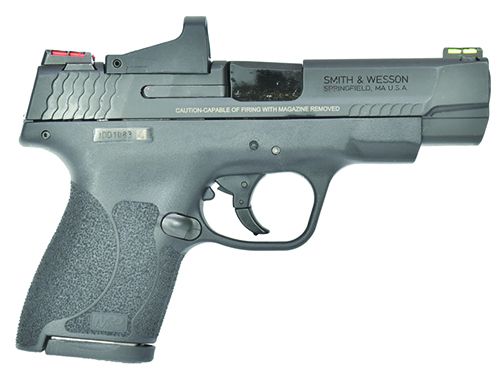
| Action Type | Semi auto, striker fired |
| Overall Length | 7.1 in. |
| Overall Height | 5.13 in. |
| Maximum Width | 1.04 in. |
| Weight Unloaded (no magazine) | 20.1 oz. |
| Weight Loaded | 26.5 oz. w/9 rounds |
| Slide Material | Stainless steel, Armornite finish |
| Slide Retraction Effort | 13.7 lbs. |
| Receiver Material | Polymer |
| Finish | Black |
| Front Strap Height | 1.8 in. |
| Back Strap Height | 3.0 in. |
| Barrel Length | 4.0 in. |
| Grip Thickness (Maximum) | 0.95 in. |
| Grip Circumference | 5.2 in. |
| Magazine | (1) 7 round & (1) extended 8 round |
| Rear Sight | Fiber optic in drift-adjustable dovetail |
| Front Sight | Fiber optic in dovetail |
| Sight Radius | 5.9 in. |
| Trigger Pull Weight | 4.3 lbs. |
| Trigger Span | 2.1 in. |
| Safety | Trigger safety, hammer block |
| Warranty | Smith & Wesson Lifetime Service Policy |
| Telephone | (800) 331-0852 |
| Website | Smith-Wesson.com |
| Made In | USA |
The Performance Center did some extra magic on this pistol. The trigger has been improved considerably both in weight and crispness. Trigger compression only required 4.3 pounds on average. There is some take-up before the shooter gets to the pressure wall, as on most striker-fired pistols. After that point is reached, there is very little creep, and the trigger breaks cleanly. The PC even added an overtravel bump behind the trigger to cut down on required trigger movement and to speed reset.
The sights were improved from the standard three-dot set to fiber-optic sights both front and rear. The front sight is a single, green-optic tube covered by what can best be described as a cage. The rear sight is a double set of red-optic tubes also surrounded by a cage. These cages allow a lot of light to reach the optic tubes while still protecting them from damage. Stippling on the grips has been improved to allow a much more secure grip. It’s perhaps even a bit too aggressive in texture, and we would suggest that some sort of garment be worn between the shooter’s skin and the pistol. The sides of the slide are scalloped both front and rear to allow the slide to easily be retracted or a to perform a simple and safe press check.
Last, the slide is already milled and drilled for the mounting of a Shield SMS sight, which is included in this package. The SMS version of the sight is slightly larger than the RMSc, but the difference is small enough that we had to use a set of calipers to make sure our eyes weren’t deceiving us. The way the SMS sight is mounted on the Shield pistol allows the user to leave the rear sight on the pistol when the SMS is installed. We like that.
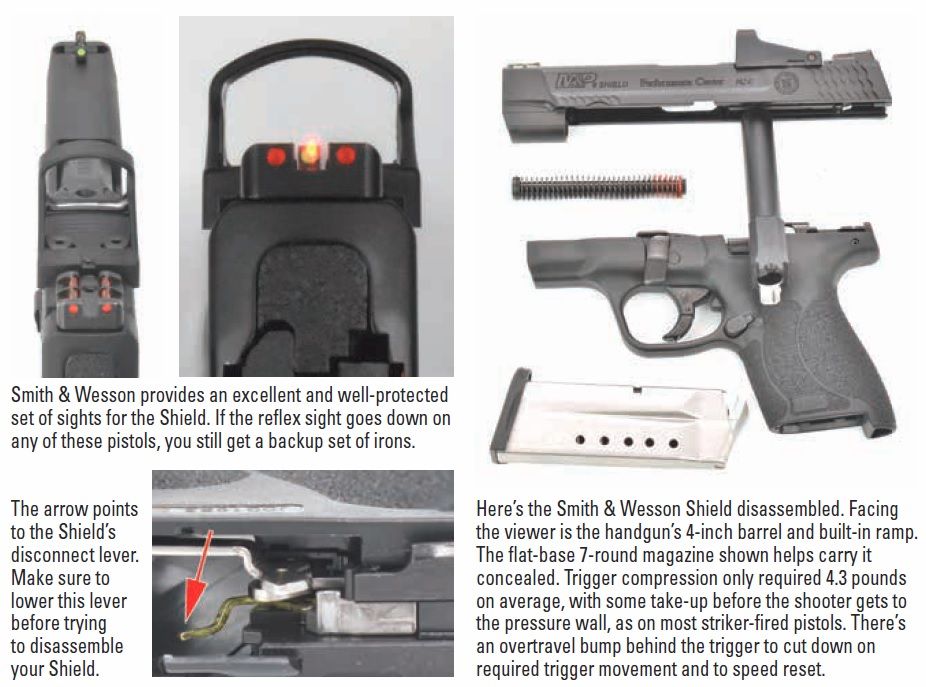
Battery longevity is a concern with any electronic device. How long will they last? In the case of an electronic sight, how easy are they to access for replacement? Does the sight have to be removed and, if so, how much work and time are involved to sight the pistol back in? The Shield sight website claims that batteries should last two to three years under normal usage. This is not an on/off switch relying on motion-detecting technology. The sight is on 24/7 and this is just expected battery life. We can’t hold onto these guns for years as part of the test, but we can report that sights have stayed on for several months without problems or any weaker beam. The Shield RMSc and SMS models require the sight to be removed to change the battery. We found this to be easy to do, and the zero was closely maintained when we put the sight back on.
Our Team Said: The Shield has the longest barrel we tested in this group of pistols. We felt that extra weight out front softened the recoil and the muzzle flip noticeably. Function was flawless. This pistol had the lightest trigger in this group. While still very safe, we thought it contributed to the overall shooting results. The Shield allowed excellent speed and, except for the magazine capacity, might well have been our overall top pick. If you think eight (plus one) is enough for you, check out the Performance Center Shield.
Springfield Armory Hellcat Micro-Compact OSP HC9319BOSP 9mm Luger, $550
GUN TESTS GRADE: A (OUR PICK)
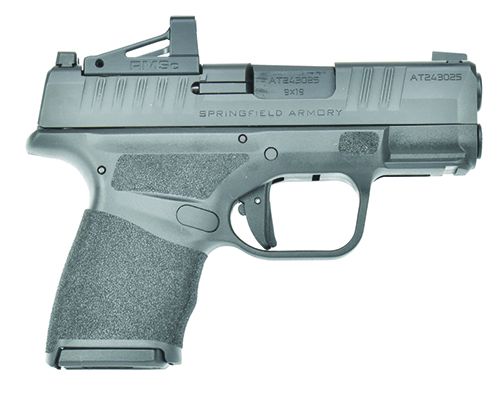
| Action Type | Semi auto, striker fired |
| Overall Length | 6.0 in. |
| Overall Height | 5.25 in. w/mag extension and red dot sight |
| Maximum Width | 1.06 in. at slide stop |
| Weight Unloaded (no magazine) | 15.9 oz. with red dot |
| Weight Loaded | 23.3 oz. w/12 rounds |
| Slide Material | Forged steel, Melonite finish |
| Slide Retraction Effort | 17.7 lbs. |
| Receiver Material | Polymer |
| Finish | Black |
| Front Strap Height | 1.625 in. |
| Back Strap Height | 2.5 in. |
| Barrel Length | 3.0 in. |
| Grip Thickness (Maximum) | 1.06 in. |
| Grip Circumference | 5.25 in. |
| Magazine | (1) 11 round & (1) 13 round extended |
| Rear Sight | Drift adjustable w/white outline U-shape notch |
| Front Sight | Tritium lamp outlined with high-vis green circle |
| Sight Radius | 5.1 in. |
| Trigger Pull Weight | 5.75 lbs. |
| Trigger Span | 2.875 in. |
| Safety | Trigger blade, hammer block |
| Warranty | Limited warranty |
| Telephone | (800) 680-6866 |
| Website | Springfield-Armory.com |
| Made In | Croatia |
The Hellcat OSP, unlike the standard Hellcat, ships with the slide already cut for a red dot but does not offer a package that includes a red-dot sight at this time. The mount on the pistol is designed to fit the Shield RMSc or a JPoint sight. Since no dot sight is included, the pistol comes with a cover plate over the mount. The slide is cut with cocking serrations front and rear. The cover plate, when attached, includes matching serrations that go over the top of the slide – something that is functional and eye-catching. The slide sports an excellent set of sights. The front is a steel blank with a tritium lamp surrounded by a light green plastic insert. The rear is sight “U” shaped with a white outline below. The rear sight does not have to be removed to install the RMSc sight, which we greatly prefer. The height of the sights allows them to co-witness through the red-dot’s viewport, making them perfectly usable if the optic fails.
The trigger also reminds us of a product from that little company in Austria, with a couple of improvements. The trigger face is almost flat, allowing the finger to go low on the trigger and provide more leverage. The sear breaks at about 90 degrees, which we prefer, and, like the S&W Performance Shield, there is an overtravel bump behind the trigger, limiting rearward movement. Controls protrude no more than necessary and are recessed into the sides of the polymer frame.
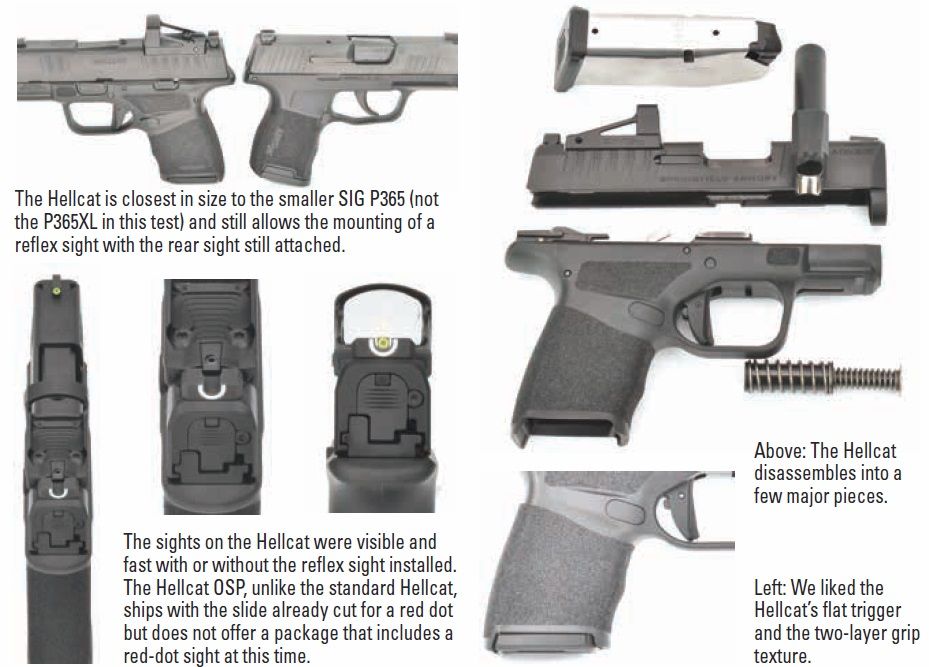
The frame itself has what Springfield calls “Adaptive Grip Texture.” This texture has at least two levels of pyramids, if you will. The higher level has been somewhat flattened to lessen irritation when the pistol is carried against the skin. We could feel the difference in adhesion to our hands when we increased pressure on the grip. But when pressure is applied, a more aggressive point is encountered, and the grip adheres better to the hand. The trigger guard is undercut to allow the highest possible grip. The sides of the magazine well are relieved to allow the shooter to grab the base plate on the magazine in case of a malfunction. The front strap also includes a standard Picatinny rail. The recoil spring is a double, captured and nested affair that, along with the recoil-spring guide rod, creates some stand-off capability in case something is pushing against the front of the slide.
Perhaps the greatest concern about red-dot sights are their durability. Will a given sight survive in the real world? We didn’t want to abuse the sight, but we didn’t want to have to baby it either. We wanted to make sure that the Shield RMSc sights would continue to work through a lot of shooting and a lot of slide manipulations. A video Springfield posted for this pistol and sight combo shows them using the front of the RMSc sight as an edge against which they pushed in order to rack the slide. Of course, we had to do that, too. The sight didn’t fail and didn’t lose zero.
Our Team Said: The Hellcat went through more than 200 rounds without a hiccup. The Springfield Armory Hellcat OSP was, in our opinion, the snappiest of the pistols tested. But that didn’t stop it from posting very competitive times in our drills. We just had to hold onto the pistol hard. The Hellcat won our overall accuracy tests by a small margin, but win it did. It seemed to shoot everything we fed it. We think that of the four handguns tested here, the Hellcat would be the only pistol that might realistically be pocket-carried if needed — even with the optic installed.
SIG Sauer P365XL 365XL9BXR3 9mm Luger, $579
GUN TESTS GRADE: A
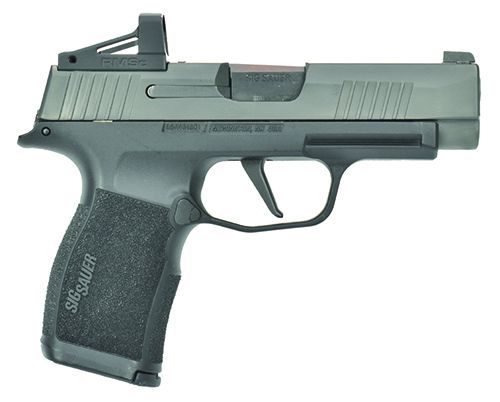
| Action Type | Semi auto, striker fired |
| Overall Length | 6.6 in. |
| Overall Height | 5.25 in. |
| Maximum Width | 1.1 in. at magwell only, 1 in. max width at the slide stop |
| Weight Unloaded (no magazine) | 17.8 oz. |
| Weight Loaded | 25.9 oz. with 13 rounds |
| Slide Material | Stainless steel, Nitron finish |
| Slide Retraction Effort | 14.6 lbs. |
| Receiver Material | Polymer |
| Finish | Black |
| Front Strap Height | 2.1 in. |
| Back Strap Height | 2.75 in. |
| Barrel Length | 3.7 in. |
| Grip Thickness (Maximum) | 1.17 in. |
| Grip Circumference | 5.1 in. |
| Magazine | (2) 12-round flush fit |
| Front Sight | Fixed with tritium insert |
| Rear Sight | Drift adjustable with tritium insert |
| Sight Radius | 5.5 in. |
| Trigger Pull Weight | 4.9 lbs. |
| Trigger Span | 2.7 in. |
| Safety | Firing pin block |
| Warranty | Limited lifetime |
| Telephone | (603) 610-3000 |
| Website | SIGSauer.com |
| Made In | USA |
Many of the desirable features of this pistol remained unchanged. The slide is stainless steel with a Nitron finish. There are very functional cocking serrations front and rear on the slide. The extractor is external, and other controls are large enough to be easily activated while being small enough to stay out of the way. X-RAY 3 Day/Night sights are standard issue. The front sight is not fiber optic but is still very visible. The sight body contains a tritium lamp that glows green in the dark. The lamp is surrounded by a green plastic insert that our tests showed to be very visible in the sunlight. The rear sight also has two tritium lamps in a metal body that can be used as a flat surface suitable for slide manipulation in an emergency.
The slide is milled out to allow the mounting of a red-dot sight. The cover for that milled slot is attached by two screws accessible from the bottom of the slide. When those two screws are removed, the cover-plate comes off, along with the rear sight, as two separate units. Please note the installation of a red-dot sight requires the removal of the rear sight. If you mount a red dot on the P365XL, you will not have a dedicated rear sight. The Shield RMSc has a cut in the rear of the sight body that allows a rear sight/front sight to co-witness while the red dot is installed. This same slot can also serve as an emergency rear sight. We tested the effectiveness of the slot and it worked fine at 7 yards, but not as well as the standard rear sight.
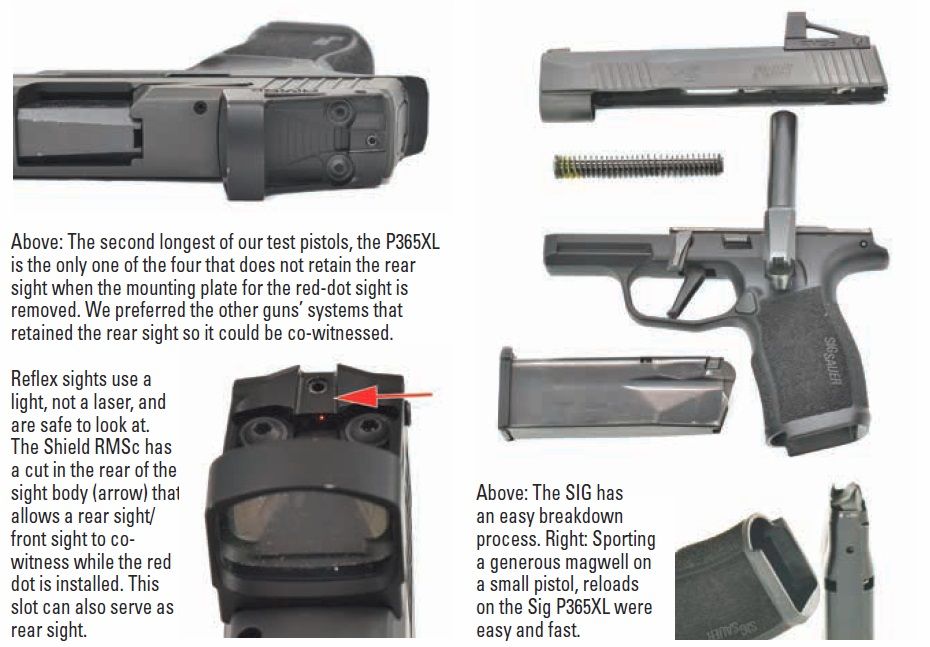
There were a few more improvements we really like. The first was changing the curved trigger to a flat trigger like those used in SIG P320X models. The geometry of the flat trigger creates an almost vertical break point for the sear release and gives the shooter a bit more leverage. We found both of those points to aid our shooting with this pistol. Next was the slight lengthening of the grip frame. A majority of people should now be able to get most of three fingers on the grip, which also helps in controlling the pistol under recoil. Like many other polymer-framed pistols, the magazine well on the P365XL is beveled to help the rapid insertion of a new magazine. The P365XL goes beyond that point and actually flares the magwell to make an even bigger opening. Our calipers show this only added a very acceptable 0.1 inch to the width of the pistol. This is still a very thin firearm. Though one of our very few complaints is that it is thin to the point where a Picatinny rail would not work with the design. A proprietary rail is on the forend, but that can limit available accessories.
Every illuminated sight will be used in widely varying circumstances and differing amounts of ambient light. Changes in available light on the target change the amount of light throughput required from the sight. The bright light that is required to see the dot in direct sunlight will almost blind the shooter trying to use that sight later in the evening. Dot sights have to adjust the amount of light thrown on the glass. One of the ways to do this is manually by the shooter, which is fine in a competitive situation. That may not be so great for a defensive encounter. What if the shooter is moving from sunlight into a dimly lit room and doesn’t have time to fiddle with the rheostat? The Shield RMSc senses the light available at the target and changes the beam intensity. The only problem we really noticed with the programming was when we would stand in a lighted area and point the sight at a more dimly lit target. The beam did not get dim enough and bloomed a little bit on the target. We could still see to hit the targets just fine.
Our Team Said: The SIG P365XL did almost everything well. It functioned every shot, first try. Accuracy was excellent, with its average group only being .06 inch larger than the winning Hellcat. Speed and accuracy on the drills was outstanding, with the P365XL winning two of the four drills and coming in second place on the other two. Our group of testers preferred the P365XL’s trigger. But we did not like having to remove the rear sight to mount the optic. We shot a 15-yard drill with five shots from the low ready. We did the drill once with the iron sights and then again utilizing the red dot sight. The SIG P365XL does not maintain its rear sight with the optic attached, so we had to use the channel provided on the Shield RMSc sight. The SIG posted the slowest time on this drill without the red dot and the fastest time with it. We’ve seen too many things go wrong and would prefer to have that rear sight.
Walther PPS M2 2805961 9mm Luger, $649
GUN TESTS GRADE: A (BEST BUY)
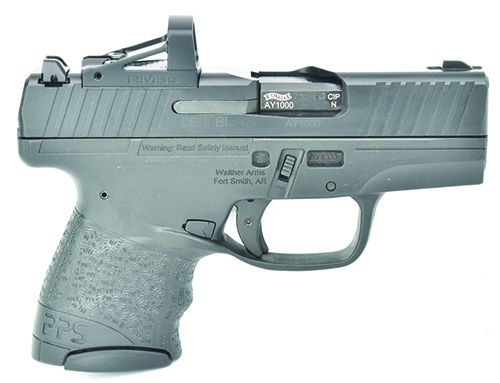
| Action Type | Semi auto, striker fired |
| Overall Length | 6.31 in. |
| Overall Height | 4.81 in. with red-dot sight |
| Maximum Width | 1.04 in. |
| Weight Unloaded (no magazine) | 18.9 oz. w/red-dot sight |
| Weight Loaded (8 rounds) | 24.7 oz. |
| Slide Material | Steel, Tenifer coated |
| Slide Retraction Effort | 19.1 lbs. |
| Receiver Material | Polymer |
| Finish | Black |
| Front Strap Height | 1.5 in. |
| Back Strap Height | 2.75 in. |
| Barrel Length | 3.2 in. |
| Grip Thickness (Maximum) | 1.04 in. |
| Grip Circumference | 5.3 in. |
| Magazine | (1) 6-round flush-fit magazine & (1) 7-round extended |
| Rear Sight | Steel with white dots, drift adjustable |
| Front Sight | Steel with white dot |
| Sight Radius | 5.4 in. |
| Trigger Pull Weight | 4.9 lbs. |
| Trigger Span | 2.8 in. |
| Safety | Trigger blade, hammer block |
| Warranty | Limited lifetime |
| Telephone | (479) 242-8500 |
| Website | WaltherArms.com |
| Made In | Germany |
Without the red dot we have on our sample, we would liken the pistol most closely to a Glock 43, and the Glock influence is very obvious. The trigger has the same look, feel, and blade-type safety of a Glock. If you are familiar with the internals of a Glock and look at the trigger components of the PPS M2, you are going to feel right at home. The pistol disassembles using the same twin tabs on either side of the slide. There is a difference in the takedown versus the Glock in that while the trigger has to be pressed before the slide comes off, that action is taken after the tabs have been pulled down and the slide has started forward. Another big difference is the steel insert inside the frame. Most polymer-framed pistols seem to have minimal contact between the slide and the metal frame. The slide frequently rides on small tabs located fore and aft as well as on either side of the frame. The rails on the PPS M2 occupy the entire right side of the steel frame along with two approximately 1-inch-long rails on the left side. Old 1911 shooters preach solid slide-to-rail contact. Walther says it improves accuracy. We checked it out for you.
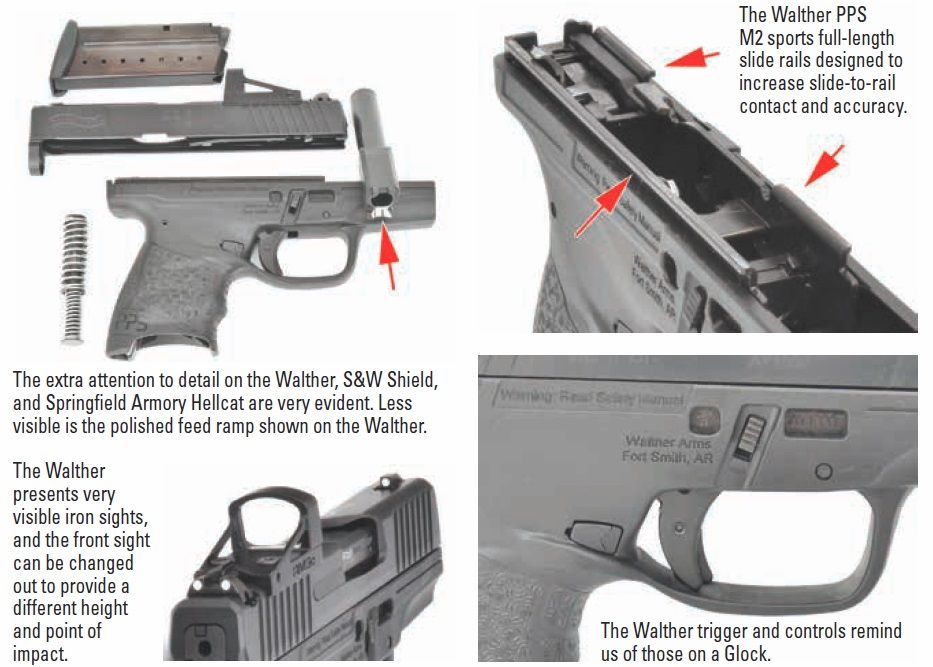
The slide and metal parts are Tenifer treated, which is a ferritic nitrocarburizing process also used on Glock pistols. There are cocking serrations located front and rear. They were sharp enough to be useful without being so sharp as to cut up our hands. There is a cocking indicator located in the rear of the slide, which puzzles us a bit. When uncocked, the indicator is forward, inside the slide. When the slide is operated, partially cocking the striker, the indicator comes flush with the rear of the slide. As the trigger is compressed, thus fully cocking the trigger prior to sear release, the indicator extends from the rear of the slide. We would like to see the indicator protrude far enough out from the rear of the slide to allow a tactile check without having to compress the trigger further. The pistol has steel front and rear sights, showing the familiar three-dot pattern. The rear sight is drift adjustable for windage. The front sight has a mounting screw, and the manual says that various-height sights are available as an accessory from Walther. They should be very easy to swap out and change vertical point of impact. The slide is milled for the Shield sight, which is held in place by two solid screws. The sight’s location on the slide allowed the rear sights to stay on the pistol when the red dot was mounted, and we really liked that.
Our Team Said: The Walther PPS M2 functioned perfectly through all tests and drills. The PPS wound up in second place in our accuracy tests, losing on average group size by a mere .03 inch. Maybe those long rails really do matter.
Written and photographed by Joe Woolley, using evaluations from Gun Tests team testers.
Value Guide: 9MM Luger Handgun Rankings
| GUN NAME | ISSUE | GRADE | COMMENTS |
|---|---|---|---|
| Arex Rex Delta REXDELTA-01 9mm Luger, $425 | Feb. 2020 | A | Best Buy. Reliability and practical accuracy are good, and the pistol is the right size for concealed carry. |
| Stoeger Industries STR-9 31721 9mm Luger, $350 | Feb. 2020 | B | If you like the Glock 17, you will like the STR-9. Worth the money, but it is not our favorite. |
| Ruger Security-9 Compact Model 3818 9mm Luger, $309 | Feb. 2020 | B | The pistol is adequate for the task and will not break the bank. |
| SIG P365 Nitron Micro-Compact 9mm Luger, $465 | Feb. 2020 | B | The SIG costs more than the Ruger Security-9 without overwhelming advantages. |
| S&W M2.0 PC Shield 11787 9mm Luger, $430 | Jan. 2020 | A | Best Buy. Smooth and accurate, great sights and trigger. Costs a lot less than the SIG. |
| SIG Sauer P365XL P365XL-9-BXR3 9mm Luger, $580 | Jan. 2020 | A | Our Pick. The SIG P365XL was the most accurate of the four pistols tested. |
| Springfield Armory XDE9 XDE9389B 9mm Luger, $460 | Jan. 2020 | A | Slide is easier to retract, hammer-fired, DA/SA trigger set the XDE apart in this test. |
| Springfield Hellcat Micro-Compact 9mm Luger, $500 | Jan. 2020 | F/A | Hellcat #1 failed when the trigger wouldn’t reset (F). Hellcat #2 worked perfectly (A). Best accuracy. |
| Glock 43X Ameriglo Night Sights PX435SL301AB 9mm Luger, $542 | July 2019 | A | Our Pick. Firing grip is superior to the G43 and allows better shooting with little compromise. |
| Glock 48 PA485SL301AB 9mm Luger, $488 | July 2019 | A | Best-shooting pistol in the test and the most powerful. Minimally more difficult to conceal. |
| Mossberg MC1sc 89001 9mm Luger, $365 | July 2019 | A- | Best Buy. The Mossberg 9mm gave up little to the Glock designs. Reliability was never a question. |
| Springfield XD(M) 4.5 9mm Luger XDMT9459FDEHCE TB, $505 | Apr. 2019 | A | Our Pick as a personal-defense, home-defense, and tactical pistol. |
| Glock G34 Gen5 MOS PA3430103MOS 9mm Luger, $710 | Apr. 2019 | A | The Gen5 guns are the best yet, with superior accuracy and features over earlier Glocks. |
| CZ-USA CZ P0-9 91620 9mm Luger, $402 | Apr. 2019 | B | Best Buy. CZ has managed to pack a lot of value into the P0-9. 19-round magazine. |
| FNH FNS-9L Longslide 66725 9mm Luger, $570 | Apr. 2019 | B | Heavier trigger than the other pistols. Accuracy wasn’t as good. |
| Glock 45 9mm Luger, $546 | Jan. 2019 | A | Fast from concealed carry. The action allows a trained shooter to make fast hits. Reliable. |
| Beretta APX Compact JAXC921 9mm Luger, $449 | Jan. 2019 | B | Magazines were difficult to load. Slide was difficult to rack. Takedown button too tight. |
| SIG P320-M17 320F-9-M17-MS 9mm Luger, $770 | Jan. 2019 | B | The grip fits most hands well and the sights are excellent. The DAO trigger was too heavy. |
| Beretta 92 FS JS92F300M 9mm Luger, $562 | Jan. 2019 | B | Shows the age of its design with a slide-mounted decocker and long DA trigger pull. |
| Taurus G2S 1-G2S931 9mm Luger, $204 | Nov. 2018 | A | Best Buy. The Taurus pistol was reliable and controllable in rapid fire. |
| Smith & Wesson M&P9 Shield SW180021BW 9mm Luger, $400 | Nov. 2018 | A | The Battleworn Shield is reliable, accurate enough, and compact enough for EDC. |
| Bersa BP9MCC 9mm Luger, $295 | Nov. 2018 | A- | Reliable, feels good in the hand, and offers excellent handling in fast-paced drills. |
| Honor Defense Honor Guard HG9SCF FIST 9mm Luger, $400 | Nov. 2018 | A- | The FIST option is viable. We tested it against barricades with excellent results. |
| Ruger EC9s 3283 9mm Luger, $231 | Nov. 2018 | B- | Most accurate handgun of the test, despite its light weight. |
| Smith & Wesson M&P9 M2.0 Compact 11686 9mm Luger, $476 | June 2018 | A | Pleasing trigger action, good gripping surface, a rail, and grip inserts. |
| Glock G19X G5 PX1950703 9mm Luger, $594 | June 2018 | A- | Has many of the good features of the Gen5s. Fast from leather, fast on target, reliable. |
| Ruger SR1911 L’wt Commander 6722 9mm Luger, $739 | June 2018 | B | For those who like the single-action 1911 cocked-and-locked, this is a good choice. |
| SIG Sauer P225-A1 Nitron 225A-9-BSS-C 9mm Luger, $880 | June 2018 | B- | Slim grip appeals to shooters with small hands. No rail and low magazine capacity. |
| Glock 17 Gen5 9mm Luger, $545 | Mar. 2018 | B- | A credible firearm, but the sum of its parts is not a great leap forward. |
| CZ-USA CZ P-10 C 91520 9mm Luger, $480 | Feb. 2018 | A- | Best Buy. Well-designed sights, decent trigger, ambi slide lock and magazine catch. |
| Lipsey’s Glock 17RTF2 Vickers FDE 9mm Luger, $630 | Feb. 2018 | A- | Our Pick. Includes Vickers Tactical sights, a mag guide, and mag basepads. |
| Beretta 92FS W/Wilson Combat Upgrades 9mm Luger, $550 | Feb. 2018 | B | Smooth, well finished, and the most accurate handgun tested. Grip did not fit all shooters. |
| Arex Rex Zero 1 Standard FDE 9mm Luger, $634 | Feb. 2018 | B | Fit, finish, and an absence of internal tool marks show high build standards. |
| Smith & Wesson M&P9 M2.0 11537 9mm Luger, $599 | Dec. 2017 | A | A refined striker-fire pistol with a crisp trigger, excellent grips, and good accuracy. |
| Springfield Armory XD MOD.2 4-In. Service 9mm Luger, $565 | Dec. 2017 | A- | Easy to shoot due to the fiber-optic front sight, textured grip, and consistent trigger. |
| Ruger American Pro Duty 8605 9mm Luger, $579 | Dec. 2017 | B+ | The American is capable and ran well with good accuracy. Grip inserts gave trouble. |
| Kimber Micro 9 Desert Tan (LG) 3300168 9mm Luger, $659 | Oct. 2017 | A | The laser grip complements the large sights on this micro pistol. |
| SIG Sauer P938 Emperor Scorpion 9mm Luger, $639 | Oct. 2017 | A | With large sights, a crisp trigger and toothy grips, this was easy to shoot and control. |
| Springfield Armory XD-E 3.3 XDE9339BE 9mm Luger, $519 | Oct. 2017 | B | Trigger geometry took some getting used to. Decocker was hard to manipulate. |
| Walther PPS M2 2805961 9mm Luger, $451 | Sept. 2017 | A | The Walther PPS M2 is a class act. It was the most expensive pistol tested this month. |
| Smith & Wesson M&P9 Shield 180021 9mm Luger, $394 | Sept. 2017 | A | Best Buy. Well designed grip checkering, good sights, and a decent trigger action. |
| Glock 43 Subcompact Slimline G43 PI4350201 9mm Luger, $445 | Sept. 2017 | B | Accurate enough for personal defense, reliable, and fast handling. |
| Honor Defense Honor Guard Sub-Comp. HG9SC 9mm Luger, $449 | Sept. 2017 | B | The only defect was the problematic slide lock, which was too heavy to operate quickly. |
| Taurus 709 Slim 1-709031FS 9mm Luger, $198 | Aug. 2017 | A | Best Buy. We would buy this gun, and we would carry it for personal defense. |
| Kel-Tec PF-9 9mm Luger, $257 | Aug. 2017 | A- | The Taurus outshot the Kel-Tec, but that doesn’t mean the PF-9 is out of the running. |
| SIG Sauer P938 Micro-Compact 938-9-ESR 9mm Luger, $730 | Aug. 2017 | B | The pistol had enough break-in glitches to be rated down a full grade. |
| Remington R51 96430 9mm Luger, $400 | Aug. 2017 | D | It simply refused to function with one type of ammunition. The trigger was poor. |
| Ruger American Compact 8633 9mm Luger, $579 | July 2017 | D- | We could not complete our tests without reseating the recoil assembly multiple times. |
| Honor Defense Honor Guard HG9CLE 9mm Luger, $499 | July 2017 | B+ | Admirably fills the role of a highly concealable fighting gun that’s inexpensive and fun. |
| Springfield Armory 1911 EMP PI9229L 9mm Luger, $1220 | July 2017 | A | The EMP delivered accuracy and ergonomics on par with more expensive custom guns. |
| CZ-USA 75D PCR Compact 91194 9mm Luger, $546 | July 2017 | A | We like everything about the 75D except the absence of a light rail. |
| Tristar Canik 55 C-100 9mm Luger, $365 | July 2017 | C | |
| CZ-USA 75 P-01 9mm Luger, $576 | July 2017 | A |


























